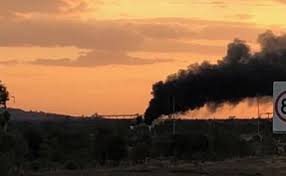
John Anger SSE (Site Senior Executive) North Goonyella. US Court Filing Peabody Energy
2021-03-19 – 0038 PEABODY ENERGY – AMENDED COMPLAINT (3023799.1) (1)
Again I have searched and collated any Section of the Filing that mentions Mr Anger
Senior Site Executive (senior level position at a mine). At North Goonyella, Mike Carter was the SSE starting before the Class Period through April 2018 when John Anger became the SSE and Carter moved to a different position at Peabody.
61. CW-2 was employed as a Process Engineer for Peabody from February 2014 to July 2018 and rotated between the Moorvale, North Goonyella, and Wilpinjong mines. CW-2 worked at the preparation plant or the CHPP (coal handling and preparation plant) where he monitored the incoming and outgoing coal for quality. CW-2 reported to Paul McKenzie (former CHPP Maintenance Superintendent) who in turn reported to John Anger (then Director Safety Health Environment at North Goonyella).
78. CW-7 explained that Peabody monitored gas levels at North Goonyella in a number of ways. According to CW-7, one form of monitoring within the mine included twice daily MOP (Mine Operational Plan) meetings between all staff at the superintendent level and higher. According to CW-7, the MOP meetings took place twice daily: (i) in the morning where they reviewed the previous 24 hours; and (ii) in the afternoon (prior to the beginning of the night shift) to discuss the next 24 hours. CW-7 explained that in the MOP meetings, the group discussed what was meant to happen during those timeframes and then what did happen, including any specific events. CW-7 confirmed that during his tenure in 2018, John Anger (Director Safety Health Environment) and Marek Romanski (then Underground Mine Manager), or a representative on Romanski’s behalf, would attend the MOP meetings.
92. CW-6 explained that another key decision that was detrimental to the operations at North Goonyella was replacing Site Senior Executive (“SSE”) Michael Carter with John Anger in April 2018. CW-6 advised that Carter was retained at North Goonyella, but Anger was appointed as the most senior member of the mine. CW-6 explained that Anger lacked the technical background of Carter and that CW-6 was “concerned” about Anger’s lack of experience in underground mines. CW-6 added that ultimately it was Anger’s job to ensure the health and safety of the mine as the most senior mine official.
112. CW-6 advised that neither he, John Anger (SSE) nor Steven Stook (Tech Services Manager) were onsite from August 31 – September 2, 2018, and that he did not receive a prompt to check the automated messages from the mine that would have informed him of that the Level 4 trigger had been reached (indicating high carbon monoxide levels and oxidation) on September 3, 2018.
118. CW-9 advised that MREs prepared by the QMI in September 2018 reflect the discussions of the daily morning meetings at North Goonyella, where he received gas figures, discussed the prior day, plans for the current day, and offered his recommendations. CW-9 recalled that the participants in these daily meetings included: (i) Peter Baker (former Senior Vice President – North Queensland Operations); (ii) John Anger (Senior Site Executive), (iii) Marek Romanski (then Underground Mine Manager), (iii) Martin Watkinson (technical expert from SIMTARS), and (iv) Darren Brady from Serinus Health and Safety Environment. CW-9 dealt with Peter Baker and recalled that Charles Lilly (Senior Director – Engineering) was brought in from Peabody U.S. to assist. CW-9 explained that as SSE, John Anger primarily was responsible for the business functions of the mine and that Marek Romanski, as UMM, was the primary decision maker regarding underground operations until Mike Carter was brought in as a consultant during the spontaneous combustion event in order to provide Romanski with opportunities to take breaks from the mine due to the expectation that the impending schedule would be very demanding. CW-9 explained that over time, Carter eventually assumed the responsibilities of the UMM, in terms of power, but not in title.
128. Beginning in September 2018, CW-8 (who served as Planning Coordinator at North Goonyella for approximately 7-10 months starting in September 2018), collected data from the various shifts at North Goonyella and compiled the data into reports in an effort to determine the best course of action. According to CW-8, this included gas data and pressure readings. CW-8 provided the reports to senior level mine staff, including: (i) John Anger (SSE), (ii) Marek Romanski (then Underground Mine Manager) and (iii) Mike Carter (Vice President – Operational Support). CW-8 confirmed that his reports also were shared with Peabody Australia Headquarters in Brisbane, who were “closely associated” with the efforts in the mine.
130. CW-8 recalled the “Startup Tour” meetings that occurred prior to each shift change where the IMT, including John Anger, Marek Romanski and Mike Carter, provided updates to the incoming shift. CW-8 explained that there were short and long-term plans for reentering the mine, but senior mine staff was hesitant to provide specific dates. According to CW8, there were “ever-changing issues” and a regular flow of new information that altered timelines. According to CW-8, these variables made it “extremely difficult to make predictions.” According to CW-8, specific dates would typically only be provided in response to a question from the workforce and these would come with the caveat of being reliant on things continuing on the current trajectory without any issues arising.
145. On September 4, 2018, the QMI inspector convened another meeting at the North Goonyella mine, this time with: (i) Marek Romanski, (ii) John Anger (the SSE), and (iii) others to discuss the status of the high carbon monoxide levels in the 9N Tailgate. By that point, methane levels in the mine had risen from 6% to 14.02%. Romanski claimed that in the past 24 hours, they “started to develop a re-entry plan,” but according to the QMI Inspector, the “actions to date were managing the Oxygen but not addressing the heating.” Romanski further stated, and Anger agreed, that the mine was “intending to proceed until they were certain the risk
- Daily meetings with the QMI and senior mine personnel including Marek Romanski (UMM), Mike Carter, John Anger (SSE), and Charles Lilly (Director of Engineering) continued, during which the status of the high carbon monoxide levels in the 9N Tailgate were discussed.
- For example, in a September 9, 2018 MRE, one of the QMI inspectors referred to the “Spon Com” event on the site of the North Goonyella mine, stating that he attended a meeting at North Goonyella Mine to discuss the status of the 9 North goaf which is being monitored for accelerated oxidization resulting in a Spon Com event. A September 22, 2018 MRE also referred to the existence of a spontaneous combustion event having already transpired. Specifically, the MRE for this date notes that additional QMI inspectors were on site to “continue monitoring the mine’s progress in managing a spontaneous combustion event occurring at Longwall 9 North recovery faceline.”
- On September 10, 2018, the QMI inspector attended a meeting to discuss the rising carbon monoxide levels and its potential cause(s).40
- On September 11, 2018, it was discovered that the Floxal Unit was injecting gas into the wrong area of the mine. 41
- On September 12, 2018, gas results confirmed carbon monoxide on the Maingate (“MG”) side of the Tailgate Chute Road. The QMI Inspectors again advised Peabody senior mine personnel to review the North Goonyella Sealing Management Plan as the longwall had not yet been permanently sealed. 42
- On September 13, 2018, the QMI again advised that Peabody must revise its Sealing Management Plan and reconsider whether the current TARPs the Company was using were still relevant.43
185. According to CW-1, he and Nick Oakley were in charge of the financial projections with operational input from John Deakins (Development Manager). CW-1 explained that in his role, he was reliant on the figures and information provided by the operational employees in terms of how much it would cost to get the mine functional again. According to CW-1, John Anger and Michael Carter were responsible for the mine forecasts. CW-1 recalled that Andrew Muir (Director Financial Projects) was tasked with scrutinizing the forecasts and determining the budget and timing for the recovery efforts. CW-1 confirmed that Muir was doing a lot of work to help with “the estimation of the recovery in dollars.”
193. CW-1 explained that following his re-location to Brisbane, John Anger, Mike Carter, and Andrew Muir continued to lead the North Goonyella recovery efforts. According to CW-1, while working at Peabody’s Australian Headquarters in Brisbane he worked on the “life of mines” modeling and long-term forecasting for Peabody’s Australian mines. CW-1 recalled conducting this type of analysis on North Goonyella 8 or 9 months following his departure from his role at North Goonyella (this would be approximately in July or August 2019). CW-1 advised that his work included producing models to help determine if re-opening North Goonyella was a viable option. CW-1 explained that he ran a “couple of scenarios,” including one in which Peabody were going to seal up all the north panels and then attempt to mine the south panels and another in which Peabody would seal up 9N and 10N and mine 11N. CW-1 advised that “obviously they tried to get back into production as soon as possible,” noting that he never got the sense that sealing up the mine permanently was ever an option and that Peabody wanted to recover the equipment and continue mining. According to CW-1, the projected timetable to return to mining at North Goonyella at this time was between 2022 and 2025 and that the models were “pretty intensely scrutinized” as North Goonyella was the “jewel of the Australian platform.”


